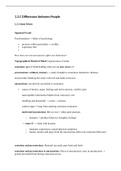1.2.C Differences between People
1.2.1 Inner Drives
Sigmund Freud:
Psychoanalysis→ father of psychology
pressure within personality→ conflict
experience thre
How does our unconsciousness affect our behaviour?
Topographical Model of Mind: regions/areas of mind
conscious: part of mind holding what you are now aware of
preconscious: ordinary memory→ easily brought to awareness (memories, dreams)
not presently thinking but easily retrieved and made conscious
unconscious: not directly accessible to awareness
source of desires, urges, feelings and tied to anxiety, conflict, pain
unacceptable information hidden from conscious view
troubling and distasteful → aware→ anxious
control urges→ keep from entering conscious awareness
motivated unconscious: life on own→ other parts unaware
o dynamic→ produce behavior, thoughts, feelings
→ Anna O → client with hysteria
o traumatic experiences caused physical symptoms
o trauma, desires and urges from the unconscious affect our conscious behaviour
conscious and preconscious: Material can easily pass back and forth
conscious and preconscious to unconscious: Move to unconscious, once in unconscious →
person prevented from having conscious access
, Mental gate prevents retrieval
o mental gate blocks the unconscious memories, urges, desires from moving to
the preconscious/conscious
Delay of Gratification:
o impulses and urges at a later time→ mature personality and socialization
→ experiment children and reward
factors:
o objet in front of sight→ harder
o transform object mentally ( image in head)
o distraction→ ego tricks by getting involved in something else
o Personality: higher value achievement and social responsibility→ better delay
o boys: ability to control emotional impulses, concentrate→ ego-function
(control ID expression)
o girls: intelligence, resourcefulness, competence→ recognize delay as sit.
appropriate response
What 3 factors are shaping our identity? (ego, superego, ID)
The Structural Model:
**ID:**original component of personality ( present at birth)
o instinctive, primitive aspects, original
o part that wants
o psychological nature of infant
o needs pleasure and gratification
o impulses, instinct, desires
o entirely unconscious → engine of personality→ source energy
pleasure principle: all needs satisfied immediately
o release tension immediately
o unsatisfied→ aversive tensions state
primary process:
o forming an unconscious mental image of desired object/event necessary to
release tension
wish fulfillment: creation of unconscious image of desired object
o mental image if it contains an object
EGO: express IDs impulses effectively → exectuive role personality
, o functions unconscious
o rational part fo personality
o dealing pragmatically with reality
o restraints we learn (danger to grab too fast)
wants to satisfy the Id, in a safe manner
rationalized
o ego considers the reality
o ego develops strategies to release tension
o mediated desires and constraint extrenal
o developed in first 2-3 years of life
o level: unconscious, pre-conscious, conscious
reality principle: external reality with internal needs and urges
o delay discharge until appropriate object found
o actions must take into account constraints of external reality
secondary process: match image to real object→ seek to satisfy desire ID
o matching the object of the primary process and comparing it to the reality
object
reality testing: test mentally and realistic
o reality testing: delays the tension release through calculation of the possible
outcomes (whether it is viable)
egos checking to see whether the plan will work before it is put into action
Ego strength: deal effectively with competing demands
o superego too strong→ guilt
o ID too strong-Y obsessed with self-gratification and uninterested in others
:
SUPEREGO:
o parental and societal values
o abstract rules to be part of society
o seek moral perfection
o morals
o rules
goes against the Id
o developed around the 5th year of life
developed through following parent’s morals and values
o level: unconscious, pre-conscious, conscious
introjection: avoid pain→ avoid parents wrong and do their right
, o absorbing values of parents into superego
ego ideal: rules for good behavior → strive for
represents perfection and rewards for good behavior
o strong superego = ego is unable to balance Id and superego
conscience: disapprove/punish for behavior→ avoid→ feelings of guilt
punishes violation of moral standards
o tries to prevent any ID impulses disapproved by parents
o force ego to act morally and not rationally
o guide to perfection ( removed reality→ civilizing)
The Drives of Personality:
psychic energy: motivate all human activity
amount of psychic energy individual possessed and remains constant over lifetime
drive: biological need and psychological representation
hydraulic model: drive state built until action causes their tension to be released
Eros: survival, reproduction, pleasure (life/sexual instincts)
Libido: collective energy life instincts ( hunger, pain, avoidance, sex)
o energy arising physiological process
o self-preservation instincts → need to reproduce
o self-preservation (eros) & sexual instinct (libido)
o need-satisfying, life sustaining, pleasure oriented urge
o sexual instinct → pleasure, basic needs, finite energy
Thanatos: death instincts:
apoptosis: death is the ultimate goal for parts of body→ biologically programmed
cell death
o agression→ self-destructive urges
o destroy, harm
o can be released through aggression
Catharsis:




